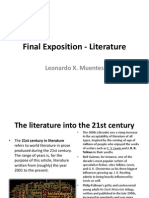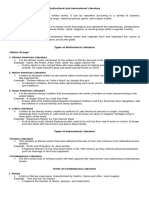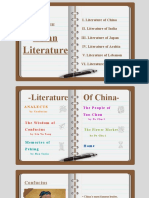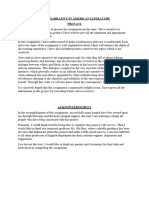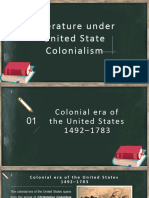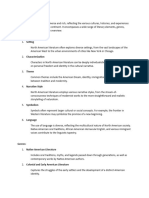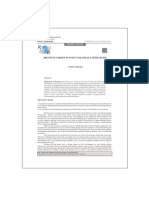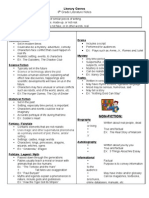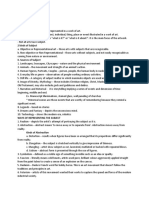Professional Documents
Culture Documents
LIT2 Reviewer
LIT2 Reviewer
Uploaded by
Jialyn BulacOriginal Description:
Original Title
Copyright
Available Formats
Share this document
Did you find this document useful?
Is this content inappropriate?
Report this DocumentCopyright:
Available Formats
LIT2 Reviewer
LIT2 Reviewer
Uploaded by
Jialyn BulacCopyright:
Available Formats
WORLD LITERATURE
• A struggle between Western influence and
• Emerged in the 19th century when literary Asian identity.
connections between different countries • This paved way to many works of literature
began to spread inspired by such a struggle of identity.
• This happened about 200 years ago when • Being in a foreign country yet also feeling the
humanity's cultural heritage strengthened and need to belong and not belittled.
we were able to trade works of literature to
different countries
Rules of the Game
Why Do We Study World Literature? This is an excerpt from the 1989 novel (The Joy Luck
Club) written by Amy Tan. The novel talks about life and
• Understand the lives of people from all over the relationships between Chinese immigrant families and
world what they have experienced in a foreign place. The
• Have a world outlook (different perspectives story revolves around a child prodigy named Waverly
and points of view Jong who was named after the place she grew up in:
• Acquaint ourselves with the masterpieces of Waverly Place.
literature
• The relationship between mother and daughter
is highlighted in the excerpt.
• Waverly Jong soon found out she was not just a
THE RULES OF THE GAME regular child but a child prodigy with the talent
of playing chess.
Chinese Immigration to the US Immigration is very • Waverly's mother saw the skill her daughter
common in Asia. Many Asian individuals have possessed and spurred her on. Tensions clash
permanently migrated and settled in different areas of between Waverly and her mother within the
the world. During the early 19th century, a lot of excerpt.
Chinese migrated to the US. There were 3 common
reasons why migration rose around that time.
• They wanted to gain more financially. Reflections of Culture in literary works
• They wanted freedom.
• They wanted to escape British dominance over • Amy Tan, like many other authors who write on culture
China. and identity as their premise, uses glimpses to show the
identity of a certain culture.
The Chinese Exclusion Act and the Magnuson Act • In literature, reflections of culture can be seen
through subtle or blatant signs. Such examples are:
Due to the rise in the number of Chinese immigrants,
the US enacted the Chinese Exclusion Act in 1882. This slang (the way a person speaks - it may not
act prevents Chinese workers from migrating to the US. even be grammatically correct) e.g. "Wise guy,
Luckily, by 1943, the Magnuson Act was passed (an act he not go against the wind."
that opposed discriminatory laws from the past).
Tradition or outlook in a certain area such as
• Chinese workers helped the US in their leaving one's footwear outside the house
economy during the Civil War. before entering.
• Chinese workers helped provide products that
can be used by American society. Items and objects with localized terms, e.g.
• Chinese workers helped in the dawn of railroad change (a small tablet of red jade which held
building. the sun's fire) or siesta (an afternoon nap)
• To be able to understand the culture in literature, one
Chinese communities in the US must learn to pay attention to simple detail.
From the 19th century until now, there have been
countless of Chinese communities spread all throughout
the US. Character Analysis
How do you understand a character? Moreover, how
do you analyze a character?
Identity and Culture in Chinese Communities
In fiction, characters often carry an interest in the story.
Chinese in America is caught in a struggle of influence Some are written as complex individuals while others
and culture. There is a line drawn between cultivating are simple and predictable. Regardless of how the
their culture and also being open to Western influence. characters are portrayed in the text, there is no denying
Thus, there was a new wave of young Asians whose that these characters are one of the main reasons (if
minds are conflicted between being Westernized but not, THE main reason) why the stories come alive.
still maintaining the values of their lineage.
Ways to Analyzing a Character
Here are simple ways that one can use to analyze a
character in the story. Take note that some stories may
not include ALL the ways to analyze a character as
stated here. Regardless, at least one or two is enough
to give a good analysis of the story.
The Basics
Information that are easily given in the story.
- Age
- Name
- Appearance
The Background
The most crucial part in analyzing a character to be
able to determine whether the character is a
protagonist, antagonist, or both.
- Motive
- How they think
- Insecurities and flaws
The Behavior
Plays a significant role in the development of the
character or in how they act.
- Social standing
- Family background
- Memory/ backstory
Character Analysis
When it comes to analyzing a character, one should
always be open to the fact that this can be subjective.
This relies heavily on the reader's perspective. One
reader may prefer a character over another other but
that does not necessarily mean that the same would
go for another reader. Hence, the reason why
characters become more vivid is because of the
intrinsic connections made by the readers to the text.
You might also like
- Some of Us Chinese Women Growing Up in The Mao EraDocument245 pagesSome of Us Chinese Women Growing Up in The Mao Eraᜆ᜔ᜐᜇ᜔ ᜊᜎ᜔ᜇᜒᜇᜋᜓᜐ᜔100% (3)
- Final Exam LiteratureDocument14 pagesFinal Exam LiteratureLeonardo MuentesNo ratings yet
- Orientalism: Dr. R. SoundararajanDocument27 pagesOrientalism: Dr. R. Soundararajansoundar12100% (1)
- 21st CL - Q2 SummaryDocument7 pages21st CL - Q2 SummarysoosquishyNo ratings yet
- Gac Global IdentityDocument13 pagesGac Global IdentityDianaNo ratings yet
- MODULE 2 Contemporary LitDocument5 pagesMODULE 2 Contemporary LitjsepcervantesNo ratings yet
- 21ST Century Literature of The Philippines and The World ReviewerDocument2 pages21ST Century Literature of The Philippines and The World ReviewerYeorge BarbazaNo ratings yet
- AmericanmodernismDocument14 pagesAmericanmodernismMatt TidwellNo ratings yet
- KORE2034 - 2022F - W2 - New Women and Wise Mother and Good WifeDocument33 pagesKORE2034 - 2022F - W2 - New Women and Wise Mother and Good WifelhtNo ratings yet
- Korean and Vietnamese LiteratureDocument37 pagesKorean and Vietnamese LiteraturenfatimashalihaNo ratings yet
- Key Terms of Postcolonial LiteratureDocument11 pagesKey Terms of Postcolonial LiteratureAmeer Abdullah BalochNo ratings yet
- American Romanticism 1800-1855Document18 pagesAmerican Romanticism 1800-1855Jovito D. CabilisNo ratings yet
- Lit Notes FinaalDocument22 pagesLit Notes FinaalAlliah MaxineNo ratings yet
- Post Colonial LiteratureDocument11 pagesPost Colonial Literaturesajidsidheer100% (4)
- Finalized Lecture Group 11Document2 pagesFinalized Lecture Group 112023500653No ratings yet
- WORLDLIT - Literature of China 1Document20 pagesWORLDLIT - Literature of China 1Niko GaspeNo ratings yet
- Borderline LiteratureDocument13 pagesBorderline LiteratureaborgesfNo ratings yet
- 5 LiteratureDocument54 pages5 LiteratureAngeline CuriosoNo ratings yet
- Slave Narrative in American LiteratureDocument7 pagesSlave Narrative in American LiteratureAshmit DasguptaNo ratings yet
- Literature Under United State ColonialismDocument24 pagesLiterature Under United State ColonialismsenpailydonNo ratings yet
- Autobiography, FolktalesDocument30 pagesAutobiography, FolktalesJessica NivashiniNo ratings yet
- Zitkala-Sa American LiteratureDocument25 pagesZitkala-Sa American LiteratureM. KhNo ratings yet
- Native American Literature IntroductionDocument15 pagesNative American Literature IntroductionKianna GaspariniNo ratings yet
- The War of The WallDocument17 pagesThe War of The WallIsis FerreiraNo ratings yet
- Gac-Cultural CommunityDocument13 pagesGac-Cultural CommunityDianaNo ratings yet
- Departure and Return: One Family, Two Countries, and a World of ConnectionsFrom EverandDeparture and Return: One Family, Two Countries, and a World of ConnectionsNo ratings yet
- Journal Nur Iklima Dewi (N1D215074)Document11 pagesJournal Nur Iklima Dewi (N1D215074)eva gultomNo ratings yet
- 21ST Group 3 Shitty-Ass ReportingDocument19 pages21ST Group 3 Shitty-Ass ReportingzwendypieNo ratings yet
- Thesis African American LiteratureDocument4 pagesThesis African American Literatureevelyndonaldsonbridgeport100% (2)
- Journal of Children's Literature: January 2009Document12 pagesJournal of Children's Literature: January 2009Delavemia RNo ratings yet
- What Means Switch ProjectDocument11 pagesWhat Means Switch Projectapi-535494343No ratings yet
- Week 2 Part 1 _21st ClpwDocument100 pagesWeek 2 Part 1 _21st ClpwMarion April AlmoroNo ratings yet
- Multilateral Oppression of Women in Julie OtsukaDocument47 pagesMultilateral Oppression of Women in Julie OtsukaSubha Lakshmi SNo ratings yet
- Cultural Studies TheoriesDocument22 pagesCultural Studies TheoriesRitesah MadhunalaNo ratings yet
- A Semi Detailed Lesson Plan in The Elements of FictionDocument14 pagesA Semi Detailed Lesson Plan in The Elements of FictionMarife AbadiaNo ratings yet
- Humlit Lesson 3Document5 pagesHumlit Lesson 3che villNo ratings yet
- 9bf6a5b1eec648f42be99bc1a37f2dacDocument42 pages9bf6a5b1eec648f42be99bc1a37f2dacJanloyd AndigNo ratings yet
- North American Literature Is Diverse and RichDocument3 pagesNorth American Literature Is Diverse and RichAo HarukiNo ratings yet
- Characteristics and Genre of English-American LiteratureDocument23 pagesCharacteristics and Genre of English-American LiteratureArlene Emily CuaresmaNo ratings yet
- James Joyce: Dublin 1882 - Zürich 1941Document10 pagesJames Joyce: Dublin 1882 - Zürich 1941Barbara ConcuNo ratings yet
- Park WanseoDocument13 pagesPark Wanseodanich.nik911No ratings yet
- Identity Crises in Post Colonial Literature: Review of ResearchDocument3 pagesIdentity Crises in Post Colonial Literature: Review of ResearchMubashir AhmedNo ratings yet
- PHILIPPINESDocument65 pagesPHILIPPINESAdi SoNo ratings yet
- Thesis On African American LiteratureDocument7 pagesThesis On African American LiteratureEmma Burke100% (1)
- ?Q4 21st Cent Lit ReviewerDocument4 pages?Q4 21st Cent Lit ReviewerraikitesNo ratings yet
- Lesson 5 - The Sad Young MenDocument44 pagesLesson 5 - The Sad Young MenMengni SunNo ratings yet
- Growing Up Native ThesisDocument8 pagesGrowing Up Native ThesisKarla Adamson100% (1)
- Presentation 2 Love of MagdalenaDocument14 pagesPresentation 2 Love of MagdalenaKing CajayonNo ratings yet
- PDFenDocument66 pagesPDFenCATHERINE BAGUIORONo ratings yet
- Literary Genre PacketDocument7 pagesLiterary Genre Packetcnakazaki1957No ratings yet
- Hli Lap 2 ReviewerDocument5 pagesHli Lap 2 ReviewerClaire EdogawaNo ratings yet
- E Lements of Prose: Princess M. CuisonDocument29 pagesE Lements of Prose: Princess M. Cuisonadelo cabradillaNo ratings yet
- Attachment 1Document6 pagesAttachment 1Tracy MakunguNo ratings yet
- Reading The Word To Reading The World(s) : Teaching Literature in GE CurriculumDocument18 pagesReading The Word To Reading The World(s) : Teaching Literature in GE CurriculumAbdelalim TahaNo ratings yet
- The Victorian NovelDocument13 pagesThe Victorian NovelCor InaNo ratings yet
- Essay CinemaDocument5 pagesEssay Cinemaafibojmbjifexj100% (2)
- Nbgs Emma and KatyDocument24 pagesNbgs Emma and Katyapi-428898897No ratings yet
- The Modern PeriodDocument4 pagesThe Modern Periodabeer.hussien1296No ratings yet
- Austen's PersuasionDocument22 pagesAusten's PersuasionFatema HasanNo ratings yet
- The Transcription of Identities: A Study of V. S. Naipaul's Postcolonial WritingsFrom EverandThe Transcription of Identities: A Study of V. S. Naipaul's Postcolonial WritingsNo ratings yet
- Visual StorytellingDocument10 pagesVisual StorytellingJialyn BulacNo ratings yet
- The Arabian Nights - Tales From A Thousand and One Nights (Modern Library) (PDFDrive)Document65 pagesThe Arabian Nights - Tales From A Thousand and One Nights (Modern Library) (PDFDrive)Jialyn BulacNo ratings yet
- Human Flourishing As Reflected in Progress and DevelopmentDocument14 pagesHuman Flourishing As Reflected in Progress and DevelopmentJialyn BulacNo ratings yet
- Narrative-Report Jialyn BulacDocument2 pagesNarrative-Report Jialyn BulacJialyn BulacNo ratings yet
- A) Who Are The Writers of The Message?Document6 pagesA) Who Are The Writers of The Message?Jialyn BulacNo ratings yet
- Final Requirement (GE6)Document2 pagesFinal Requirement (GE6)Jialyn BulacNo ratings yet
- The Subject of ArtDocument5 pagesThe Subject of ArtJialyn BulacNo ratings yet
- Concept of Bureaucratic Red Tape. 2. Resolution On How To Combat Red TapeDocument2 pagesConcept of Bureaucratic Red Tape. 2. Resolution On How To Combat Red TapeJialyn BulacNo ratings yet
- Human Flourishing As Reflected in Progress and DevelopmentDocument3 pagesHuman Flourishing As Reflected in Progress and DevelopmentJialyn Bulac100% (1)

